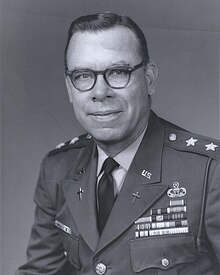Francis L. Sampson
| Francis L. Sampson | |
|---|---|

Major General Francis L. Sampson
12th Chief of Chaplains of the United States Army |
|
| Born |
February 29, 1912 Cherokee, Iowa |
| Died | January 28, 1996 (aged 83) Sioux Falls, South Dakota |
| Resting Place | Saint Catherine Cemetery Luverne, Minnesota |
| Allegiance |
|
| Service/branch |
|
| Years of service | 1942–1971 |
| Rank |
|
| Commands held | U.S. Army Chaplain Corps |
| Battles/wars |
World War II Korean War Vietnam War |
| Awards |
|
Father (Major General) Francis L. Sampson, USA (February 29, 1912 – January 28, 1996) was a Catholic priest from Archdiocese for the Military Services and an American Army officer who served as the 12th Chief of Chaplains of the United States Army from 1967 to 1971. Notably, his real-life story of rescuing a young soldier became the inspiration for the film Saving Private Ryan.
Francis L. Sampson was born on 29 February 1912, in Cherokee, Iowa. He attended the University of Notre Dame, graduating in 1937, and then entered St. Paul's Seminary at Saint Paul, Minnesota. He was ordained to the Roman Catholic priesthood for the Des Moines, Iowa, diocese on 1 June 1941. Following his ordination, Father Sampson served briefly as a parish priest in Neola, Iowa, and also taught at Dowling High School in Des Moines.
Sampson received permission from his bishop, the Most Reverend Gerald T. Bergan, of Des Moines, Iowa to enter the United States Army as a chaplain. It was at Harvard University, strangely enough, that he really began his odyssey; for it was at Harvard that new Army chaplains received their initial entry training into the Army chaplaincy during World War II. After finishing the course, Sampson volunteered for an airborne assignment. It was also a decision, he wrote later, that was made out of ignorance. "Like a zealous young business man, starting to in a strange town," he admitted, "I was ready to join anything out of a sheer sense of civic duty."
He entered the Army in 1942 and was commissioned. He then joined the 501st Parachute Infantry Regiment, of the 101st Airborne Division, as the regimental chaplain.
"Frankly, I did not know when I signed up for the airborne that chaplains would be expected to jump from an airplane in flight. Had I known this beforehand, and particularly has I known the tortures of mind and body prepared at Fort Benning for those who sought the coveted parachute wings, I am positive that I should have turned a deaf ear to the plea for airborne chaplains. However, once having signed up, I was too proud to back out. Besides, the airborne are the elite troops of the Army, and I already began to enjoy the prestige and glamour that goes with belonging to such an outfit."
...
Wikipedia
